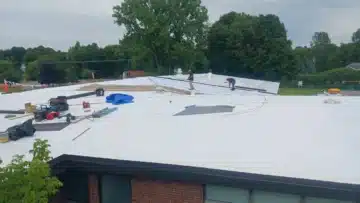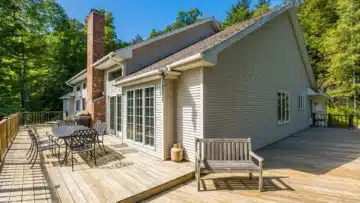When it comes to roofing materials, asphalt shingles are a popular choice among homeowners. They offer a blend of affordability and durability, but how do they hold up in extreme weather? In this blog, we’ll explore the longevity of asphalt shingles, particularly in challenging weather conditions, and what factors contribute to their lifespan.
What Are Asphalt Shingles?
Asphalt shingles are composed of a base material, typically fiberglass or felt, coated with asphalt and granules. They’re lightweight, easy to install, and come in various styles and colors, making them a top choice for many homeowners.
These shingles not only provide aesthetic appeal but also serve a significant functional purpose. Their design ensures they can withstand a variety of weather conditions while protecting your home from elements such as rain, snow, and UV rays. The versatility in design means you can find options that complement your home’s style, whether it’s modern, traditional, or somewhere in between.
One of the key advantages of asphalt shingles is their affordability. Compared to other roofing materials, they offer an excellent balance of cost and durability, making them accessible to a wider range of homeowners. Moreover, their installation process is relatively straightforward, which can lead to lower labor costs when hiring a contractor.
Factors Affecting the Longevity of Asphalt Shingles
Several factors influence how long asphalt shingles last, including climate, installation quality, and the type of shingles used. Understanding these elements can help you make informed decisions for your roofing needs.
Climate plays a pivotal role in the lifespan of your shingles. In regions with extreme heat, the granules can start to break down more rapidly, whereas, in colder climates, ice damming can be a significant concern. It’s essential to choose a shingle type designed for your specific climate to enhance durability.
Installation quality cannot be overlooked. A poorly installed roof can lead to a myriad of issues, from leaks to rapid wear. Ensuring that your roofing contractor is certified and experienced can make a tremendous difference in the overall performance of the shingles.
In addition to climate and installation, the type of asphalt shingle also matters. Architectural shingles, for example, offer more durability than their three-tab counterparts. They are thicker and designed to handle wind better, providing extended protection against harsh weather.
How Harsh Weather Impacts Asphalt Shingles
Harsh weather conditions such as heavy rain, hail, snow, and extreme temperatures can significantly impact the performance of asphalt shingles. We will discuss how these weather factors can lead to wear and damage over time.
Heavy rain can lead to water pooling, which contributes to shingle degradation. Over time, this can cause the shingles to lift or even disintegrate. Proper drainage systems, such as gutters, are crucial in mitigating this risk, preventing water from stagnating on your roof.
Similarly, hail poses a serious threat to asphalt shingles. The impact from hailstones can create dents or cracks, which become entry points for water, leading to leaks and further damage. In areas prone to hail storms, homeowners often seek impact-resistant shingles to bolster their roof’s defense.
Extreme temperatures, whether hot or cold, also affect the integrity of shingles. High heat can lead to warping or curling, while freezing temperatures can result in brittleness. Understanding your local climate is vital to selecting the right asphalt shingles that can withstand such extremes.
Maintaining Asphalt Shingles for Longevity
Regular maintenance is vital for extending the life of your asphalt shingles. Tasks such as cleaning gutters, removing debris, and checking for damage can prevent costly repairs down the line.
A proactive approach includes scheduling annual inspections after stormy seasons, focusing on checking for loose or damaged shingles. Early detection of issues like these can prevent larger problems later on.
Another critical aspect of maintenance is ensuring proper ventilation in your attic. This can help reduce heat buildup, which can warp shingles from underneath. Keeping an eye on your attic temperature can save you significant headaches in the long run.
If you notice moss or algae growth, it’s essential to address this quickly, as these can trap moisture and weaken your shingles over time. A simple cleaning solution can often eliminate these issues, boosting your roof’s longevity and appearance.
Alternatives to Asphalt Shingles in Extreme Conditions
For those living in areas with severe weather, you might consider alternatives to asphalt shingles, such as metal roofing or slate. We’ll weigh the pros and cons of these options compared to asphalt shingles.
Metal roofing is highly regarded for its longevity, often lasting 40 years or more. Its reflective properties can also reduce cooling costs during hot summers, making it energy efficient. However, the initial installation cost can be higher compared to asphalt shingles.
On the other hand, slate roofs offer unparalleled durability, with lifespans exceeding 100 years. They are resistant to fire and extreme weather, making them ideal for harsh climates. Yet, the weight of slate can necessitate additional structural support, which may be a drawback for some homeowners.
Ultimately, every roofing material has its strengths and weaknesses. It’s essential to evaluate factors such as cost, aesthetics, climate adaptability, and maintenance requirements before deciding on the best roofing material for your home.
Summing Up the Durability of Asphalt Shingles
In conclusion, while asphalt shingles have their strengths, understanding the impact of harsh weather conditions is essential for homeowners. By considering material choices, maintenance, and possible upgrades, you can extend the life of your roofing system and protect your home.



